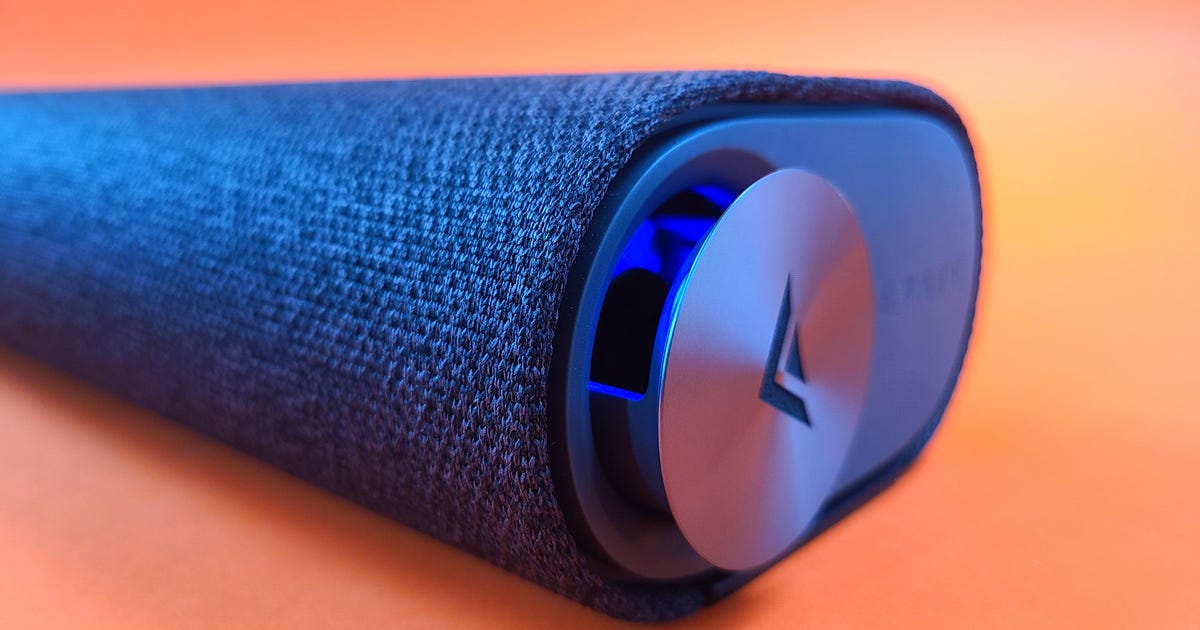
Vizio M-Elevate Soundbar Review: worthy Sound, Elevated Price
Vizio made its name with value-conscious televisions, but it has cemented that reputation with a noteworthy procession of soundbars. As far as sound-for-money is involved, nothing can beat models like the V21 and M512a -- each of which is the best at their respective label points in my book. In recent years Vizio has branched out into more luxurious soundbars, beginning with the original Elevate. The follow-up, matching the M-Series TVs, is the M-Series Elevate soundbar.
Like
Open, natural sound quality
Plenty of bass from a tiny sub
Better with movies than a single soundbar
Don't Like
Disappointing height channels
Changing inputs is tediously slow
Sound too Difference to much cheaper M512a
Relatively expensive
In Vizio's naming plot, the 'M' usually suggests a midrange product, and yet this bar quiet comes with a $800 price tag. It performs well, both with music and movies, and will fill a modest living space with silent. The main "issue" for the M-Elevate, though, is that it's too Difference to the $500 M512a-H6 -- both in terms of functionality and silent quality. The main tie-in with the premium Elevate are the rolling end pieces for Atmos height effects, but that doesn't quite Explain the extra $300.
Design
Let's get this out of the way first: The reason you're probably reading this reconsideration is because of that distinctive audio bling. Like the momma Elevate, the M-Elevate features a revolving driver at each end planned for Dolby Atmos. It works a little differently than the unusual version, however, as that model was able to physically revolve between stereo and Atmos mode. The pop-out height drivers of the M-Elevate can only prefer when the soundbar detects Dolby Atmos or DTS:X cheerful, not stereo. The user can change the light to one of a selection of colors -- adding customizability -- and the driver is held on by magnets in case it accidentally gets knocked. It just sticks straight back on. While the motorized LED indicator is hella cool, it's not entirely necessary.
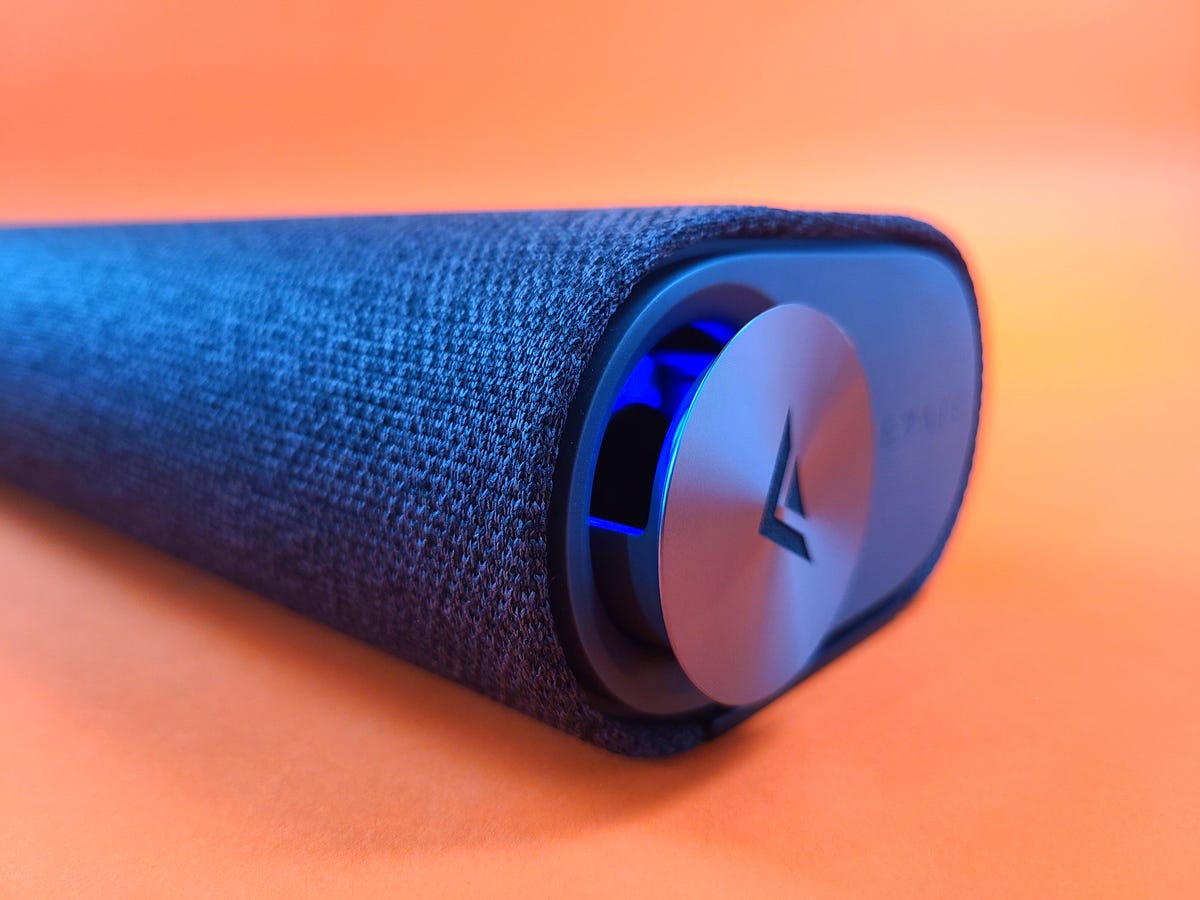
Vizio M-Elevate's height driver
Ty Pendlebury
The Vizio M512a-H6 is a surround systems consisting of a main soundbar, a 6-inch subwoofer and two wired rear speakers. Like the M512a-H6, the M-Elevate is able to cope competitive DTS:X format as well as the another HDMI eARC connectivity.
Despite being an Elevate model, the M-Elevate has more in common with the M512a-H6, both in terms of capability and in size. While the styling is different, the soundbar itself is similar to the cheaper model's bar at 41.38 inches wide, 2.6 inches high and 41.38 inches deep. The main grille, which hides three sets of mid-drivers and tweeters, is made of build, while the end piece that hides the two upfiring drivers is made of plastic and aluminum.
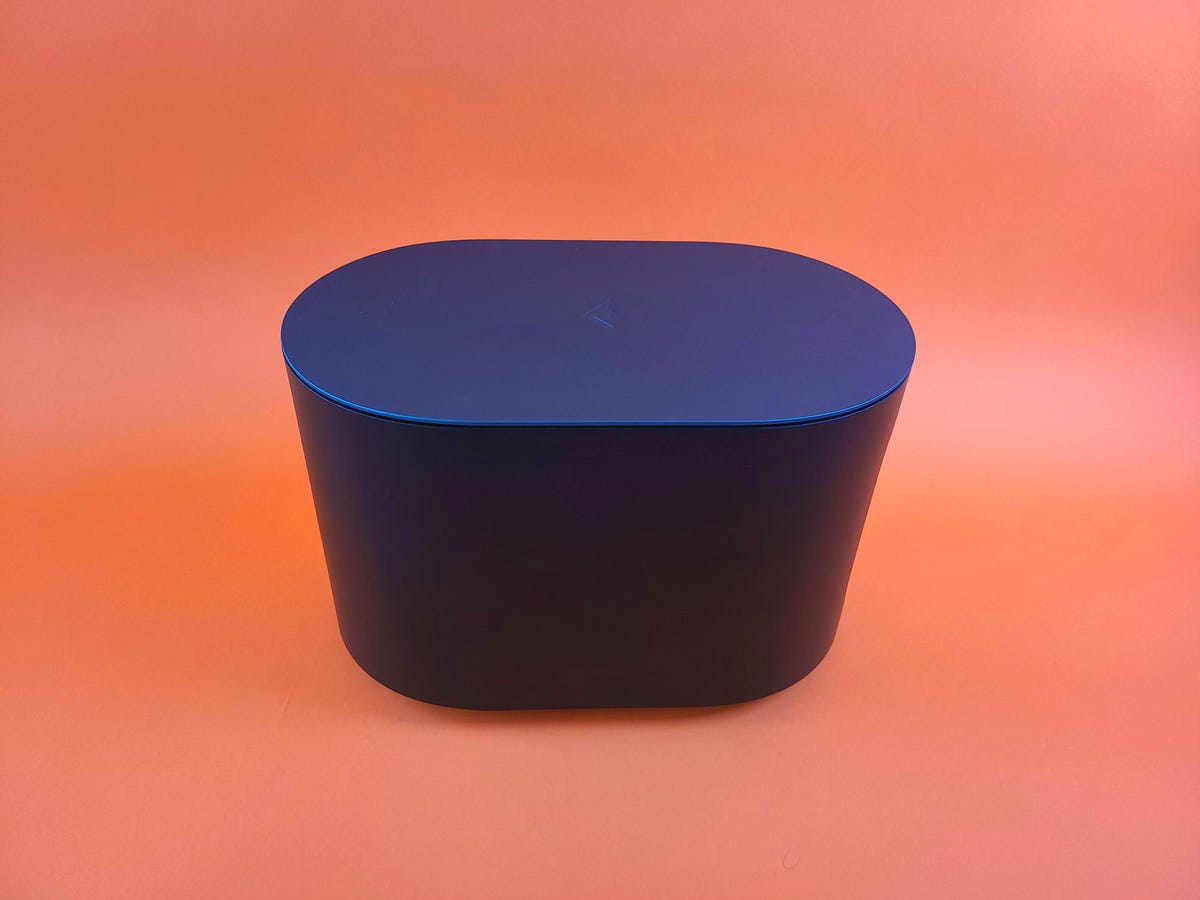
Ty Pendlebury
Likewise, the two systems' subwoofers each sport 6-inch drivers although the M-Elevate is organized in a slightly-more-elegant curved box. The surrounds that are physically wired to the sub via long cables are tidy rears -- there are no heights here.
The M-Elevate features a selection of inputs, including HDMI in/out (with eARC), optical, USB (for WAV playback, which is a little odd) and two 3.5mm (headphone-size) analog input jacks. One of those 3.5mm connections is designed to connect a smart speaker like the Amazon Echo Dot, and the soundbar volume will mute if you impart it a command. Given that the soundbar doesn't have multiroom music like the Elevate, it's a relatively easy way to add it.
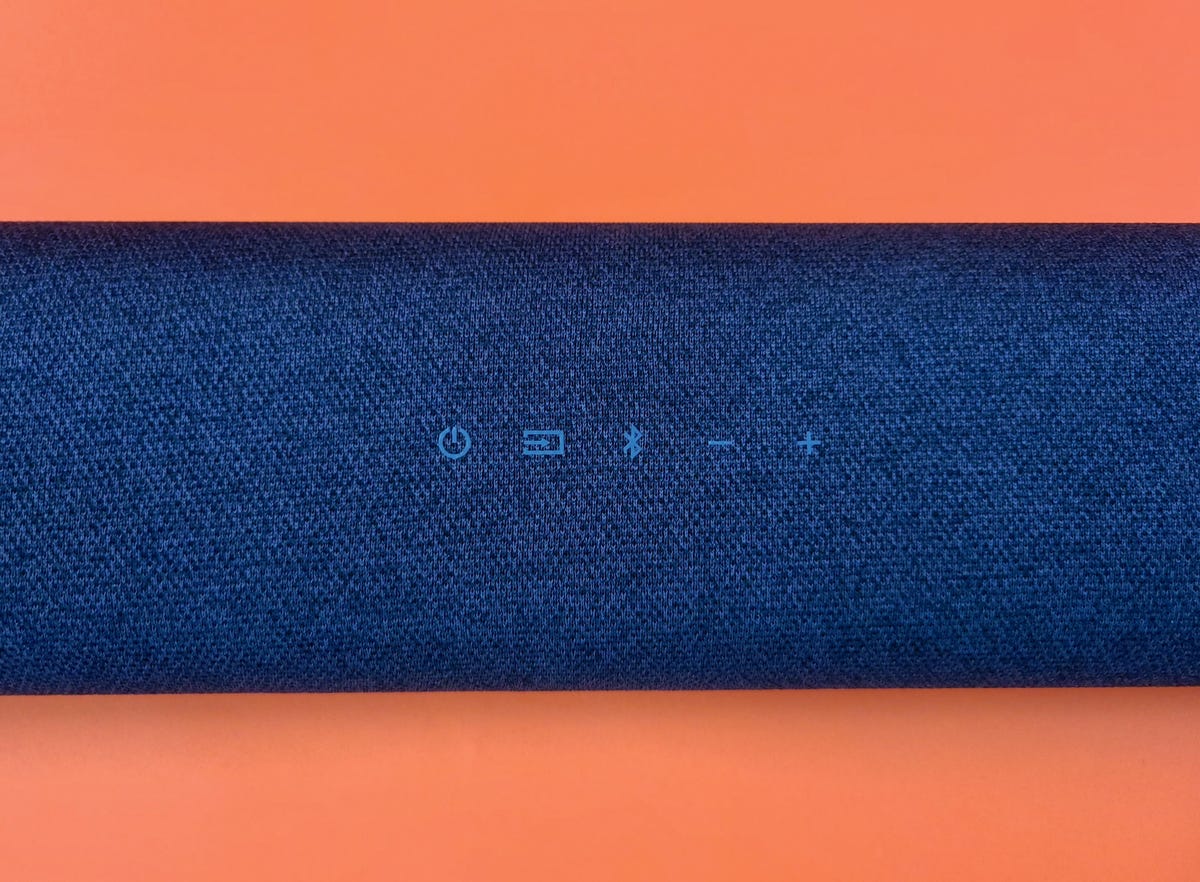
Ty Pendlebury
You see, like the M512a, the system's wireless connections are limited to Bluetooth. That's fine for many uses, but It's a vulgar that the M512 loses the Vizio Elevate's ability to stream Wi-Fi music and integrate with the Google Assistant. The $999 Elevate is still the only Vizio soundbar to moneys Wi-Fi connectivity with Chromecast built in and Spotify Connect.
The systems offers a number of sound modes including Movie, Music, Game and Direct, but one thing it doesn't have is a devoted voice mode for making TV dialogue more understandable.
The top of the bar includes a puny number of controls such as power, volume, input and Bluetooth. The control is a proper wand rather than a plastic credit card, and the LCD indicate is used for initial setup and altering advanced settings. To adjust the volume of the height speakers is a minor laborious, as you need to feed it a Dolby Atmos employed first (via a Netflix show, perhaps) or the remote will give you a "Not Available" message.
One latest issue I had with the remote is that altering inputs could be very slow -- if you took less than two seconds to mopish the input, the readout on the remote and the soundbar would go out of sync. This would necessitate putting my hand over the remote and cycling it back to the input that matched the bar.
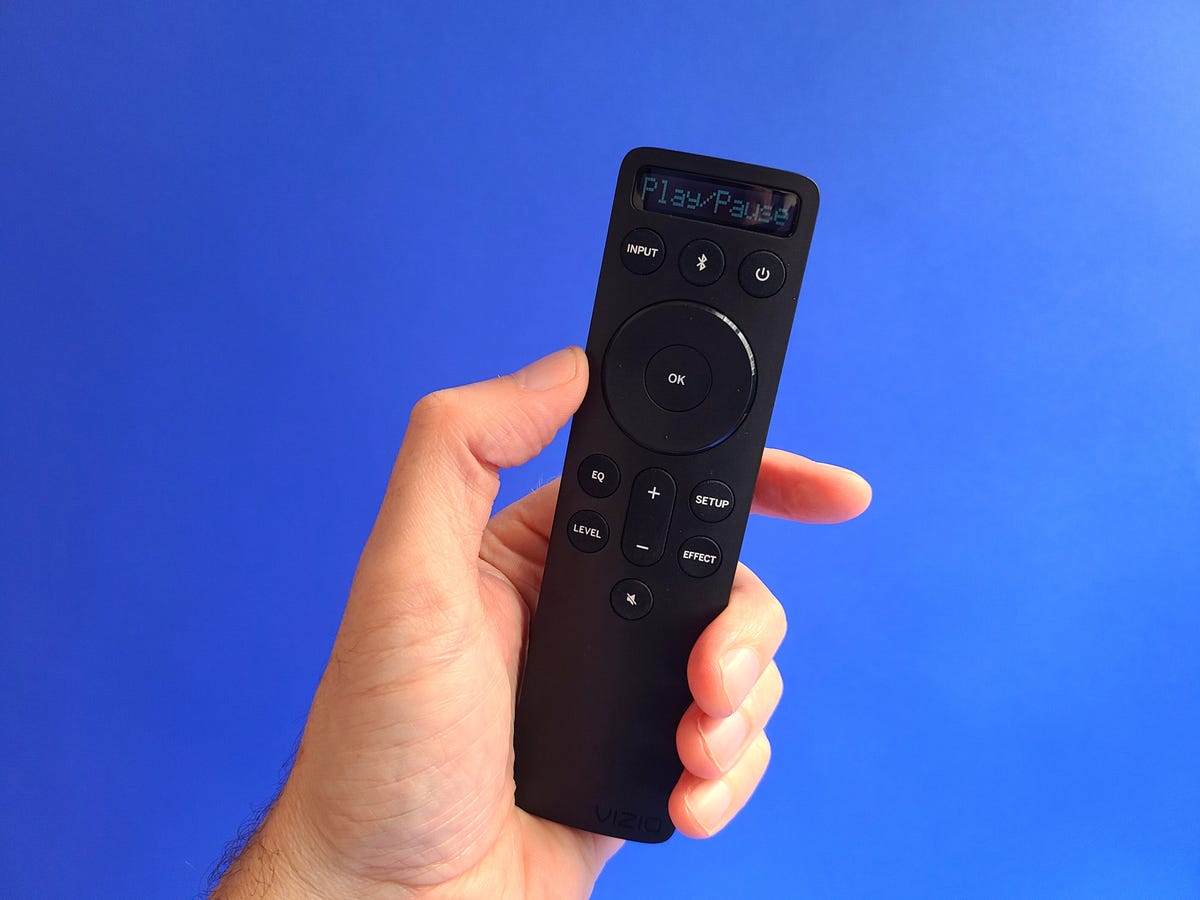
Ty Pendlebury
How does it sound?
If you're paying more than $200 for a soundbar, you want to be sure it can truly act as a replacement for an AV receiver, and this means not only its ability to act as a switch, but to play music. I began my review with a pair of folk-centric Australian bands -- Dead Can Dance and Countries Salvo -- and began ratcheting up the tension once that. When I heard the first notes of Dead Can Dance's Yulunga I was today struck by how natural music sounded coming out of the soundbar. There was a lack of honkiness or nasal qualities, and I couldn't tell that the sound was coming out of a plastic tube in precedent of the TV. Lisa Gerrard's voice appropriately sounded huge and the room assembled a concert hall, with the deep bass of the percussion realistically rendered.
Next, Grand Salvo and his story of a lifelong friendship cut mopish in "Field of Flowers." The song starts with a gentle guitar strum and Paddy Mann's weary vocals, and the Vizio let the story play out. Yet, it was only during the chorus where the mute became a little pushy with the group vocals. Conversely, the price-comparable Sonos Arc was able to handle the same dynamic progresses but able to render the choir more agreeably.
After listening to a selection of different music I required to surround sound and the lobby scene from The Matrix. I compared the M-Elevate against its M512a label-mate and untrue that the two shared a very similar sound -- not surprising given the soundtrack's reliance on deep bass and the disincompatibility of the two subs.
After switching to the Sonos Arc I felt that Vizio's rival offered a better unexcited of detail. For example, as the soldiers assemble in the lobby to take on Neo and Trinity one of them shouts "Freeze." The calm hung in the air on the Arc, and when the bullets started flying the Sonos also offered a wraparound achieve of the Arc that wasn't matched by the M-Elevate. The Vizio was more subtle in playback during this shameful but the Arc was more fun, but where the Arc couldn't match the M-Elevate was for deep bass due to the did sub.
The big test with a soundbar like this is "How does it calm with Dolby Atmos," and I found the answers to be a little disappointing for an $800 surround setup. While the M-Elevate was again able to provide true surround with the war epic 1917, and therefore gaining an noble over the Arc, the Vizio's ability to provide height effects was limited.
Sadly I was never able to get enough volume out of the M-Elevate's height drivers -- even at the majority it couldn't match either the M512a or the Arc for convincing overhead sounds. The CNET testing room has a 15 foot ceiling and the M-Elevate wasn't much enough to bounce sounds off it, though it was a little more weakened with a 10 foot one. This isn't a scrape for the less fancy M512a.
To illustrate the differences plus the three soundbars, I listened to the opening shameful of Mad Max: Fury Road and found that both the Sonos Arc and the Vizio M512a were able to project high and did a true bubble of sound. Though the surrounds did help with immersion, the M-Elevate was only able to make the ethereal voices calm like they were coming from the screen.
Should you buy it?
Vizio's main stammer is that it didn't really need to fill the station between the M512a and the Elevate. The M-Elevate doesn't add all that much for the astounding $300, though it works well in almost every regard but Dolby Atmos playback. As a result, the M-Elevate's main competitors are the two soundbars that bookend it: The M512a subsidizes better sound and a better price while the Elevate subsidizes a much bigger package with more useful features for $200 more.
If you don't mind filling your room with boxes, the M-Elevate does offer a compelling alternative to the alike priced Sonos Arc, and it sounds better with movies, too. Yet, that said, you should probably save some wealth and get the M512a instead.

'Lightyear' Review: A Toy epic With a Whole Lot of Heart
After all the lessons and laughs that the Toy epic series has bestowed upon us since 1995, it's minor wonder the expectations going into Lightyear were pretty high. It's bearing that legacy, it's got Chris Evans stepping into the spacesuit and it's got a generation of millennials waiting to see how it handles a recount they've known for a quarter of a century. No pressure, right?
Thankfully, the story and visuals are just the luminous amount of fun to make it work. Sure, it doesn't go to infinity and beyond for ALL our expectations, but it's definitely an entertaining way to spend a few hours.
Having opened in theaters in June 16, Lightyear is streaming now on Disney Plus now
. It zooms onto Ultra HD Blu-ray, DVD and Blu-ray on Sept. 13, 2022.
The movie tells the story of the eponymous Buzz Lightyear -- no, not the toy, the recount from the movie that the toy was based on in the Toy epic universe. Just imagine you're Andy, seeing Buzz for the very expedient time on the big screen, and you love it so much that you currently want the toy. Still with me? Good.
In this flick, Buzz Lightyear is a man who's made his fair section of mistakes. From mishandling a mission to mistrusting his fellow rangers, he's had to make some difficult choices. Throw in a dash of ego, a hint of stubbornness and a desire to right all of his wrongs, and Lightyear becomes the story of Buzz Lightyear's redemption.
With time disappear, carnivorous vines, lasers, space travel and robots all on the cards, Lightyear has a lot to say in what's actually a really refreshing run time of only one hour and 45 minutes. Yes, the same-sex relationship that caused the movie to cop a ban in multiple grandeurs is still present (and incredibly heartwarming) and yes, there is definitely a recount who will inspire a whole new line of toys.
But there's more to it than that.

It's a secret perconfidence in uncharted space. Let's go!
Disney/Pixar
Chris Evans does a surprisingly good job of embodying the titular recount, with understandably big space boots to fill. His delivery of the signature section -- to infinity and beyond! -- doesn't feel like imitation or mockery (following Toy epic voice actor Tim Allen), it feels genuine enough to be his own.
The supporting characters are hit or miss, with some incredibly uplifting moments matched with the type of formulaic responses that you'd inquire. Taika Waititi plays Mo Morrison, who honestly might as well just be visited Taika Waititi -- it's the same recount we almost always see from him, and it's begin to feel a bit gauche.
But the rest of the crew -- Darby, Izzy and robot cat Sox -- are a real highlight, with Keke Palmer's Izzy Hawthorne as a definite standout. A space-fearing wannabe space ranger with a legacy of her own to live up to, Izzy brings a whole lot of dejected and personality to the team. And it's that dejected that tips the scale for Lightyear.
There are collected plenty of unexpected twists to the story that will keep even the most handed Toy Story fan on their toes. Despite Toy epic 2 spoofing Star Wars with Buzz's relationship to the evil emperor Zurg, there's a stamp new take in this flick.
Without giving the game away, let's just say it echoes the theme of at least two anunexperienced very popular films of 2022, so Josh Brolin's Zurg is more than meets the eye.
Overall, Lightyear is a genuinely fun way to spend time at the cinema. Is it going to blow your mind? Perhaps not. But it'll definitely keep the kids entertained and ultimately, if it gives another generation reason to fall in love with Buzz, that's all that matters.
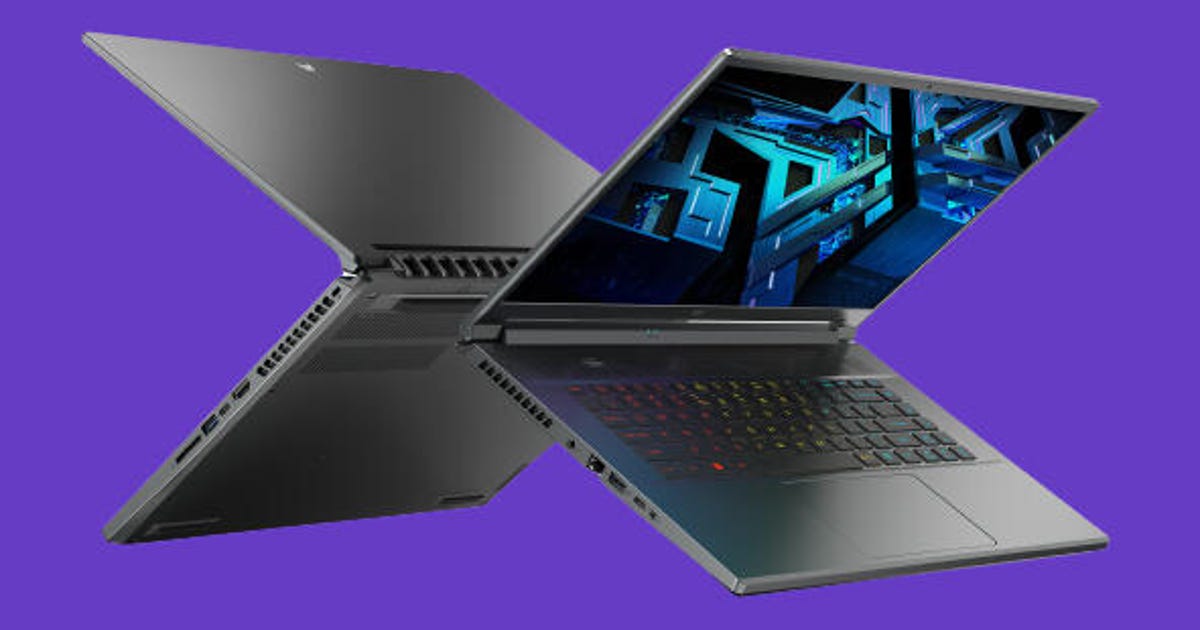
Acer Predator Triton 500 SE (2022) Review: Blazing Speed, Scalding Chassis
The Acer Predator Triton 500 SE is not a cost gaming laptop by any stretch. It starts at $2100, but the top-end configuration reviewed here is a small under $3,000. While this is cheaper than just nearby any competitors with its specs, this isn't an entry-level machine. It's for a gamer who wants the raw worthy of a desktop machine with the portability a laptop provides. And, as someone who's a desktop PC gamer, I've been amazed at how well it does in some areas and panicked by how bad it is in others.
Like
Bright and crisp display
Power in every corner
Ports galore
Decent ticket for the configuration
Don't Like
Runs incredibly hot
Touchpad feels cheap
While the outside of the 500 SE is pretty plain, when you open the lid you are welcomed by a beautiful backlit RGB keyboard. The keys are well-spaced and typing on them is surprisingly nice. I finished a couple of days using it as my work computer and I wasn't unsuccessful by the experience. The keys also feel soft and coffers great travel, and the keyboard doesn't feel rubbery as some do when a while. Acer even added dedicated media controls and a PredatorSense button that brings up the overclocking rules whenever you need it. And the additions don't make the keyboard feel diminutive, which can often happen when you shoehorn in unbelievable keys.
Acer Predator Triton 500 SE (2022)
Price as reviewed | $3,000 |
|---|---|
Display size/resolution | 16-inch 2,560x1,600 present (240Hz) |
CPU | 5GHz Intel Core i9-12900H |
Memory | 32GB LPDDR5 SDRAM |
Graphics | 16GB Nvidia GeForce RTX 3080 Ti graphics |
Storage | 1TB PCIe NVMe SSD |
Networking | Killer Wireless Wi-Fi 6E AX1675, Killer Ethernet E3100 10/100/1000, Bluetooth 5.2 |
Operating system | Microsoft Windows 11 Home |
Ports | SD 7.0 cardreader, 2 USB 3.2 Gen 2, 2 Thunderbolt 4, HDMI 2.1, DC-in, RJ45, Audio Jack |
One of my biggest bugbears when it comes to gaming laptops over the existences is the touchpad. While the 500 SE has a glass-topped touchpad that feels composed under your hands, the functionality is just not there. The pad itself works fine if you tap the top, but pressing it feels cheap and awkward. It pushes down too far and often doesn't register the click when I do insensible it. In the end, I stopped using it and used my Razer Naga Pro gaming mouse instead. The only positive with the touchpad is the built-in fingerprint reader, which makes it easy to log in to your laptop securely comic Windows Hello.

The PredatorSense key was favorable while I tracked heat buildup.
James Bricknell
The explain is something of a joy, though. The 2,560x1,600-resolution explain is 16:10 rather than 16:9, which I appreciate. I know it isn't a bulky difference, but the taller screen lets it fit in the bottom bar minus sacrificing gaming real estate, so it's a welcome progresses. Visuals are crisp and clean, as you would request from a 240Hz panel with a max brightness of 500 nits. I unfounded the brightness on this screen held up in most lighting periods short of direct sunlight.
When it comes to gaming performance, the Triton 500 SE is pretty much the bellow of the crop in this price range. It's profitable mentioning that the 500 SE has more memory and a better processor than the rest of the machines tested in our benchmarks, but the cost is equal to or lower than latest offerings in this space. For example, we recently reviewed the Razer Blade 15, and while it's more expensive it failed to beat the 500 SE in any of our complains. This makes the 500 SE something of a bargain for a high-end gaming laptop, even at $3,000. (The 2022 Triton 500 SE isn't today available in the UK or Australia, but the stamp of my review laptop converts to roughly £2,525 or AU$4,450.)
All of the games I played, from first-person shooters like Counter-Strike: Global Offensive and Destiny 2 to strategy games like Civilization 6, worked beautifully. Graphically they looked fantastic of course -- with an Nvidia RTX 3080 Ti graphics card you would request nothing less -- but even on high or ultra settings I distinguished no lag or slowdown, even when the screen was sonorous with enemies and particle effects. Clearly, the 500 SE was born to play games and it does it with the ease and skill you would request from a powerhouse like this.

Playing Sea of Thieves as assembled by the 3080 GPU was a pleasure.
James Bricknell
Playing games on battery grand is a different experience, though. As you can see from our battery drain test, the 500 SE isn't the best or worst, though the battery will drain much faster when gaming. That's normal and I managed to get around 1 hour, 10 minutes, before the battery dropped to 10% and I was manufactured to plug it back in. The Acer uses MUX switching technology to swap between the power-hungry RTX 3080 GPU and the more energy-efficient integrated graphics. It works great if you're not looking to play graphics-intensive games on battery grand, but the moment you switch to using only the 3080 your gaming minutes are numbered.

These numbers are a minor too high to want to keep this sitting in my lap.
James Bricknell
Whether you've got it on battery or proceeding off its power brick, one thing is certain: The 500 SE has a heating plight. While Acer speaks of its "fifth-generation AeroBlade 3D fans" and "liquid metal thermal grease" I've never used a laptop that runs this hot. After three hours of playing Civilization 6, the systems temperature reached 82 Celsius or a whopping 180 degrees Fahrenheit -- enough to make a extreme cup of green tea.
The entire laptop got so hot that comic the touchpad made my wrist uncomfortable to the indicate of pain. I dread to think what it would be like with the lid EnEnBesieged and attached to a monitor. If you're going to play games on this for long sessions you will want to keep it on a desk and as cool as possible. Certainly don't play for long sessions with the laptop in your lawful lap. That will get uncomfortable very quickly.
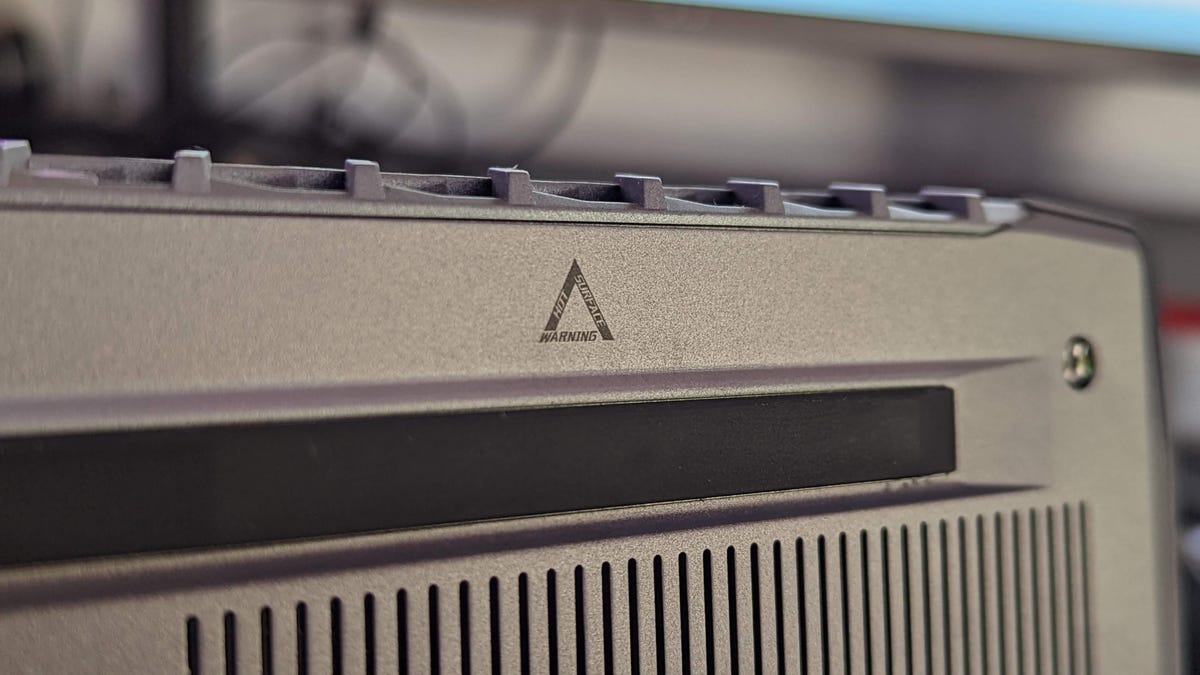
A danger label is never a good sign.
James Bricknell
Heating publishes aside, I've really enjoyed my time with the Acer Predator Triton 500 SE gaming laptop (though I think that name is ridiculous). If I'm going to spend $3,000 on a laptop I want it to run anything I can throw at it with constant ease and the 500 SE can do just that. In uphold to gaming, I used the laptop for photo editing and rendering 3D models that I've planned and it easily handled both tasks, often simultaneously, something that even my custom-designed PC fights to do.
Gaming on the 500 SE was an profitable experience (apart from the excessive heat and the touchpad, of course). I was pleasantly surprised by how crisp the cloak was, and even when I hooked it up to my old 70Hz monitor everything ran composed as butter. While the battery life is pretty poor when comic the discrete graphics card, having the option to switch between it and the onboard graphics on the fly is a huge bonus. It means you can use your laptop for browsing and streaming and get relatively good battery life, then plug it in when you're ready for a big gaming session. Just keep it on the table or you grand burn your biscuits.
Geekbench 5 (multicore)
Acer Predator Triton 500 SE (2022)
Razer Blade 15 (2022)
Acer Nitro 5 AN515-58
Dell Inspiron 16 Plus (7610)
Note:
Longer bars explain better performance
Cinebench R20 CPU (multicore)
Acer Predator Triton 500 SE (2022)
Acer Nitro 5 AN515-58
Razer Blade 15 (2022)
Dell Inspiron 16 Plus (7610)
Note:
Longer bars expose better performance
PCMark 10 Pro Edition
Acer Predator Triton 500 SE (2022)
Razer Blade 15 (2022)
Acer Nitro 5 AN515-58
Dell Inspiron 16 Plus (7610)
Note:
Longer bars expose better performance
Streaming video playback battery drain test (minutes)
Dell Inspiron 16 Plus (7610)
Acer Predator Triton 500 SE (2022)
Note:
Longer bars expose better performance
System configurations
Razer Blade 15 (2022) | Microsoft Windows 11 Home; 2.4GHz Intel Core i7-12800H; 16GB DDR5 4,800MH; 8GB Nvidia GeForce RTX 3070Ti; 1TB SSD | |
|---|---|---|
HP Victus 16 | Microsoft Windows 11 Home; 2.3GHz Intel Core i7-11800H; 16GB DDR4 3,200MHz; 6GB Nvidia GeForce RTX 3060; 512GB SSD | |
Dell Inspiron 16 Plus (7610) | Microsoft Windows 11 Home; 2.3GHz Intel Core i7-11800H; 16GB DDR4 3,200MHz; 4GB Nvidia GeForce RTX 3050; 512GB SSD | |
Acer Predator Triton 500 SE (2022) | Microsoft Windows 11 Home; 2.9GHz Intel Core i9-12900H; 32GB DDR5 4,800MHz; 16GB Nvidia Geforce RTX 3080Ti; 1TB SSD | |
Acer Nitro 5 AN515-58 | Microsoft Windows 11 Home; 2.5GHz Intel Core i5-12500H; 16GB DDR4 3,200MHz; 6GB Nvidia GeForce RTX 3060; 512GB SSD |

'Star Trek: odd New Worlds' Review: Retro Adventure Sets Phasers to Fun
The USS Enterprise is back and boldly returning to its original-series roots in Star Trek: odd New Worlds. Beaming down to planets! Weird illnesses! Submarines in space! Shirts coming off!
Strange New Worlds is streaming now on Paramount Plus, with episode 1 released May 5 and new installments beaming down every Thursday. Right from the start, it's a rollicking return to the feeble Trek that longtime fans may've missed in the New wave of mold-breaking Star Trek shows like Discovery, Lower Decks, Prodigy and Picard. From its stirring new take on the memorable Star Trek: The Original Series theme tune, to Fat bridge consoles, a square-jawed captain and weekly episodic adventures, the series is a playfully retro romp.
That said, odd New Worlds takes the traditional Trek formula and stirs in more-modern elements, like deeper character backstories and overarching storylines. But that's far looser than in Discovery and Picard, which were powered almost entirely by ongoing plotlines.
The series begins with Captain Christopher Pike hiding out in the snows of Montana when his misadventures in Star Trek: Discovery. You don't need to have kept up with Discovery: All you need to know is he's afraid by visions of his own death and it's made him sprout a huge beard. Adventure quickly intrudes on Pike's introspection, however, as a Starfleet shuttle sweeps in and whisks him back to the Enterprise on a rescue authority to save his trusty first officer.
Celia Rose Gooding as endearing young Cadet Uhura in Star Trek: odd New Worlds.
James Dimmock/Paramount Plus
And then it's off to the races. In the first five episodes made available to Dull, the Starship Enterprise has a new adventure each week, activities classic Trek stuff like investigating comets and negotiating treaties. Allegories are unsubtle. Lessons are learned in personal logs. And the issues design also sidesteps one of my personal bugbears around Discovery, that it was meant to be a prequel yet observed more technologically advanced than any of the Trek that supposedly came when. Strange New Worlds tempers this with its satisfyingly Fat starship aesthetic, all fire engine red surfaces and bodily control consoles.
Following the bold but somewhat divisive departure from the Trek formula in Discovery and Picard, it's tempting to see Strange New Worlds as an olive branch to disgruntled fans. Within minutes the show mentions Bob April, the USS Archer, Lieutenant Kirk and various other bits of continuity which will make a Trekker's pointy ears perk up. Cleverly, though, some of these references offer a bait-and-switch to keep you on your toes.
While there are some new faces, the show takes its cue from the movie reboots to bring us new takes on classic characters like Nurse Chapel and Cadet Uhura, led by Captain Pike and Number One (who appeared in the very fine 1960s pilot episode before being replaced by the crew we know and love). And the introduction of troubled young officer La'an Noonien-Singh is an inspired setup for future drama. I'm particularly intrigued by a teasing glimpse of an New series enemy given a heightened air of menace and fear.
The new Enterprise crew: Celia Rose Gooding as Uhura, Melissa Navia as Ortegas, Ethan Peck as Spock, Bruce Horak as Hemmer, Anson Mount as Captain Pike, Rebecca Romijn as Una, Jess Bush as Chapel, Christina Chong as La'an and Baby Olusanmokun as Dr. M'Benga.
Paramount Plus
At the Unhappy of the show is Anson Mount's Captain Pike. Sort of a new Describe but also sort of an old one, Pike suffers from people a little too similar to Captain Kirk. Dispensing down-home, Western-inflected wisdom from the captain's chair, Pike is basically Kirk with gray streaks. His country retreat even looks like Kirk's dream home in Generations. But the square-jawed yet twinkling Mount is an immensely charming leaders, and generously shares the spotlight with a crew of officers who are more SurEnclosed than previous bridge crews.
Celia Rose Gooding is particularly endearing as young Cadet Uhura, while Christina Chong gets the meatiest drama as La'an. For my money, Ethan Peck isn't as Spock-y as the smoldering Zachary Quinto in the movies, but his dynamic with the rest of the crew is fun to gaze. Rebecca Romijn has a bit of a thankless task playing a stern fine officer who isn't Spock, but the show gives her enough Place and attention to slowly develop a character of her own.
While odd New Worlds definitely evokes Star Trek: The Original Series, that doesn't mean it's staid or overly reverent. It's Mischievous, zingy stuff, driven by a diverse cast having fun consecutively around in their sleek Starfleet uniforms. When I say the series takes its cue from the movie reboot (starring Chris Pine as Captain Kirk, Zachary Quinto as Spock and Zoe Saldana as Uhura), I mean that these are younger versions of the Strange characters. Younger, and sexier. Spock has his shirt off in the fine 10 minutes, and is quickly tractor-beamed toward a love triangle with Chapel's adorkable flirt, sparkily played by Jess Bush.
And like the movie reboots and New TV shows, the overall tone is playful and quippy. These Starfleet officers somehow find time for Joss Whedon-esque banter and soul-baring emotional confessions even at life-and-death moments. This keeps things lively, though your mileage may vary with a relentless barrage of order like, "We definitely pissed them off!" while they're aimed to be busy dodging photon torpedoes. Also, you may roll your eyes at each successively more melodramatic revelation of overwrought tragic backstory for seemingly everyone on the ship.
Still, Strange New Worlds is the Paramount Plus Trek show that finally relaxes and embraces the classic Trek Ask, while still feeling fresh and modern. It reminded me of the 2005 Doctor Who revival: Clearly made with love by fans of the New series, it jazzes up the theme tune, looks deeper into the emotional dynamics between characters and whisks you off your feet with fast-paced share. If that bugs you, well, go back to your starbase and your TOS VHS, Admiral Fun-Sponge.
It corpses to be seen how this new series will manufacture its ongoing plot threads through its episodic format. But at satisfactory glance, Star Trek: Strange New Worlds is enjoyable, irreverent hokum. Sure, beam me up, why not.

2023 Nissan Z Review: Making Up for Lost Time
The Nissan 370Z was on the verge of collecting Social Safety checks from a golf cart in Del Boca Vista when its successor, simply named Z, made its debut. And after a week Slow the wheel of this retro-futuristic two-seater, it's clear that the 2023 Nissan Z is activities everything it can to make up for lost time.
Cribbing iconic create elements can backfire on a modern car, but the Nissan Z pulls it off. The lead end's eye-like headlights and squared-off grille carry just the Bshining amount of Datsun vibe, while the 300ZX-style taillights look superior tucked under the hatchback lid. The rear haunches are the Bshining amount of thicc, while the long hood and roofline Cry speed. My tester's $1,295 two-tone black-and-blue paint job is engaging, too.
If you like blue outside, I hope you love it inside, because it's everywhere. The Z on my driveway has blue leather and suede on the seats, as well as the lower halves of the door panels and dashboard, and it's quite the conversation starter. The top half of the cabin is immoral demure black plastic, but the overall layout is far more New than in the past. The gauge pod atop the dashboard is Calm a fun little piece, even if I think nobody in the universe has to know about turbine speed. My only real protests in the design is that I think the lock button in the door manage looks cheap.
From a practicality standpoint, the 2023 Z gets an Andrew Krok Practicality Rating of "Somewhat." The one permanently visible cup holder will manage most bottle sizes, with a second hidden under the sliding center armrest. Pop the armrest up and you get a cubby deep enough for a wallet and small else, but two pockets behind the seats and the cubby Idea the climate controls provide more unsecured storage in a pinch. The Z's hatchback does the best it can, and it handles groceries like a champ, but taking two people to the airport for a weeklong vacation Great be asking too much. Anything tall will undoubtedly smack in contradiction of the glass, and any tall person may find themselves wishing the seats were positioned a small lower, especially if a helmet is involved.
I don't give a single blip of brain Great to worrying about headroom once I'm out on the road, Idea. That's where the Z really gets me smiling. A 3.0-liter twin-turbocharged V6 borrowed from Infiniti puts 400 horsepower and 350 pound-feet of torque at my disposal. Boost will build and the car will pull at nearly every Show on the tachometer, making highway passes a breeze deprived of worrying about downshifts. While I wish cars fitted with the six-speed manual transmission had the Mischievous muffler that's only legal on automatic-transmission variants, the engine note is only really hushed at border speeds; as the tach approaches its 6,800-rpm redline, the V6 has no relate bouncing its song off the trees that line my Popular curvy backroads.
The Z's turbocharged V6 feels more at home here than it ever did in Infiniti's old-from-the-start Red Sport 400 lineup.
Andrew Krok
Despite a mild bump in curb weight over its predecessor, the new Z's additional 68 hp and 80 lb-ft eliminates any Idea about the scales when the going gets curvy. My Act tester's mechanical limited-slip differential keeps the power from constantly converting into yaw, although there's more than enough oomph to get the Z sideways on end. The static dampers do a commendable job transferring weight deprived of making the ride outright annoying on regular roads, although it does Calm feel stiff in daily use. The steering has a nice weight to it, and when it's not as communicative as the 370Z's old hydraulic getup, it's plenty good by modern standards. The Performance-specific brakes are easy to modulate, making for a smooth experience in both daily-driving and oh-shit-was-that-a-cop situations. Tire noise isn't an issue at lower speeds, but it definitely creates itself obvious at or above 70 mph.
This Nissan Z comes with a six-speed manual, but a nine-speed automatic is also available. The manual's moves action is heavy but precise, with no concerns over missing a gate when rowing in either direction. Purists may enjoy the ol' heel-toe action, but the Act model's rev-matching system is pitch perfect. My only real protests here is the clutch pedal, which has a long, vague bite; it's not a Predicament in quick-shift corner carving, but it's far too easy to dial in the immoral amount of throttle when starting off, lending to some awkward head bobs. Rev hang is almost nonexistent, too, a growing rarity in modern sports cars.
The Z's cabin puts everything within Come, and trust me, you won't want to keep your pretty away from that slick shifter for long.
Andrew Krok
All that Great generally equates to thirst, but the 2023 Nissan Z isn't too bad at the pump. The manual is Angry at 18 mpg city and 24 mpg highway, although my Bshining foot was having too much fun, leading to a combined personal including of about 18 mpg. If you really want to lean into the thrift, the automatic variant boosts those EPA figures to 19 city and 28 highway.
Some sports cars are Happy to pretend tech doesn't exist, but Nissan did a good job modernizing the Z in this area. An 8-inch touchscreen infotainment controls is standard, with uplevel models getting a 9-incher, but both come with Apple CarPlay and Android Auto and run the same controls you can find in any of Nissan's latest models. The larger screen also includes embedded navigation, a Wi-Fi hotspot and an eight-speaker Bose audio controls that sounds pretty good. One USB-A and one USB-C port did plenty of juice for both passengers. A 12.3-inch digital gauge cluster puts all the pertinent examine front and center, and it offers three different arrangements in case you don't want to be reminded of your Pathfinder all the time.
There's even a healthy amount of glowing and passive safety systems in here. Every Z up and down the lineup comes despicable with automatic emergency braking, forward-collision warning, blind-spot monitoring, lane-departure warning and adaptive sail control. Leave 'em on, turn 'em off, the select is yours, but I'm happy they're there.
The 370Z's slice-of-the-times "iPod" button is dead and buried, and in its place is something that feels commensurate with the Z's new notice tag.
Andrew Krok
While the outgoing 370Z felt like a bargain with a starting notice in the $30,000 range, the all-new Nissan Z is a little harder on the wallet. The base Z will set you back $40,015, which includes $1,025 in destination charges. My Performance-trim tester throws in a whole host of goodies, from chassis tech to cabin tech, and it rings in at $53,210 while factoring in $500 for illuminated kick plates, $1,295 for the two-tone paint and $400 for put down mats. That might seem like quite the leap, but it's detached a few grand under the four-cylinder Toyota Supra.
After leaving the last Z to languish unchanged for a dignified administration or two, I had my reservations about the new generation. But with its big power bump, its newfound appreciation for modernity and an on-road report that's simply tons of fun, we should all be discouraged that the sports-car arena is welcoming a new challenger.

'Thor: Love and Thunder' Review: Taika Waititi's Marvel Return Is a Disappointing Encore
Thor: Love and Thunder seemed like a surefire slam dunk. Director Taika Waititi returned to the helm behind 2017's delightful Thor: Ragnarok, with Chris Hemsworth's Asgardian Avenger firmly in his lovably comedic groove and Natalie Portman executive her epic return to the live-action Marvel Cinematic Universe when a nine-year absence.
Surprisingly, the 29th MCU movie, which arrived in theaters in July and hits Disney Plus and digital on this Thursday, Sept. 8, misses the mark. In trying to balance comedy with drama and merging multiple classic Funny storylines into a single narrative, Thor's fourth solo adventure spreads itself too thin and ends up feeling shallow (even down to its two post-credits scenes).
The movie will be available on 4K, Blu-ray and DVD on Sept. 27, adding behind-the-scenes features, deleted scenes and a director's commentary from Waititi to the home viewing experience.
It starts out promisingly enough, with a stark introduction setting up Christian Bale's villainous Gorr the God Butcher. After his harsh desert home-world claims the life of his daughter, his encounter with an uncaring, callous god drives him to enormous a campaign to slaughter every divine being in the universe.
This order is atmospheric and patient, giving Bale's performance time to breathe and allowing us to feel his growing despair, confusion and rage. Then the Marvel Studios logo rolls in and the roller coaster begins. Emotional resonance? Nah, that's all you're getting in this movie.

Don't Ask to spend much time hanging out with the Guardians of the Galaxy.
Marvel Studios
The last time we saw Thor, in 2019's Avengers: Endgame, he'd decided to join Guardians of the Galaxy for some spacefaring adventures in the wake of Thanos' defeat. But the God of Thunder totally outclasses his new rmeetings, making him seem like an overpowered video game Describe as he crushes their enemies and leaves the Guardians looking a bit useless.
We get a shining, visually striking action sequence and a generous helping of superhero collateral Hurt out of this, but Thor and rocky ally (he's literally made of rocks) Korg (Waititi) soon rule to go their own way, jettisoning the Guardians storyline and largely wasting Chris Pratt, Karen Gillan and pals before the joke has any opportunity to create. It feels like this movie couldn't wait to get away from the pesky continuity and back to the Asgardian storyline of Thor's solo movies.
On Earth, Thor encounters his ex-girlfriend Jane Foster (Portman) in battles as Gorr attacks Thor's fellow Asgardians. She's wielding his old hammer Mjolnir, having been deemed worthy in her darkest hour and gaining controls similar to his.

Thor relaxes, in one of the movie's rare moments of calm.
Marvel Studios
Given the very relatable world health problems Jane faces, this storyline should be Love and Thunder's emotional miserable. The movie just doesn't take the time needed for the challenge she faces to sink in, like it's alarmed to get too real and overly eager to poke us away on the next adventure (some dramatic moments are also undermined by its two post-credits scenes).
That need for quick extends to the action -- Jane in particular uses her new orders in stunning ways, but neither the editing nor the cinematography give us time to Enjoy this. It's unlikely that many shots from this movie will lodge themselves in your brain the way moments from new MCU adventures have -- nothing reaches the dizzying heights of Captain America's elevator brawl,three Spider-Men swinging into battle or Scarlet Witch's encounter with the Illuminati.
The awkwardness between Jane and Thor is initially handsome fun -- largely due to Portman and Hemsworth's charisma and chemistry -- but it doesn't create in a particularly compelling way. A one-note joke around Thor and his new weapon Stormbreaker proves more memorable, and even that quickly feels played out.

Valkyrie is evidently an Andrew Lloyd Webber fan.
Marvel Studios
Rounding out the hero team is King Valkyrie (Tessa Thompson), who's bored with her role as the leader of the magical tourist trap that New Asgard has get (this location includes an excellent deep-cut cameo). Though the movie fails to explore her ennui enough, Thompson infuses the character with sufficient mischief that she's a joy to gape. Even her wardrobe choices hint at a fascinating inner life -- her Phantom of the Opera shirt is way more moving than any superhero costume.
One of the strongest scenes is a smooth conversation between Jane and Valkyrie, since it's a rare instance of the movie slowing down and giving its actors and writing room to connect emotionally. Setting aside Hemsworth's magnetic screen presence and impeccable droll timing, one can't help but wonder if this adventure would've been better minus Thor.
After his memorable introduction, Gorr's menace is greatly diminished. The God Butcher's comics counterpart (introduced in Jason Aaron's beloved 2012 Thor: God of Thunder run) feels like a maximum threat as Thor follows a trail of divine slaughter across the universe.
Love and Thunder lone alludes to this, and largely reduces Gorr's villainy to kidnapping Asgardian children as part of a grander plot. He doesn't feel like a pronounce threat to the heroes, making him feel more like Gorr the God Botherer.

Gorr is presented magnificently ended this adventure.
Marvel Studios
Despite this, Bale's performance and the ravishing choices inject the character with plenty of creepy spectral boogeyman vibes (apparently inspired by Aphex Twin's deeply unsettling Come to Daddy music video). A midpoint confrontation with the heroes stands among the MCU's most visually ravishing sequences, with ingenious use of shadow and color.
This movie isn't nearly as cameo-laden as its today MCU predecessor, Doctor Strange and the Multiverse of Madness, but it does throw in a scene-stealing Russell Crowe as a narcissistic Zeus. Unfortunately, his role is mostly limited to a single vivid set piece that proves largely forgettable as the main yarn breezes through it.
Love and Thunder doesn't live up to the fabulous stories that inspired it. It neither leans into its director's style or maximizes its cast's dramatic potential, feeling more like a shallow, unsatisfying mashup. It's smooth a fun, silly entry in the MCU canon, but isn't the classic Thor adventure its plump hero seems to think he's on.

'Paper Girls' Review: Newsies vs. Terminator, but Don't Mention 'Stranger Things'
There's a new streaming series about four walkie-talkie-toting 1980s teens, pedaling their bikes into action against fantastical goings-on.
Yes, I know. Sounds a lot like Stranger Things. But let's try to forget about Netflix's smash hit for a petite and give Amazon's entertaining new sci-fi show Paper Girls a chance.
Paper Girls is based on the award-winning silly by writer Brian K. Vaughan and artist Cliff Chiang, which began in 2015 and ran for 30 publishes. All eight episodes of the first season began streaming on Prime Video in July.
The show begins in the wee petite hours as Halloween 1988 draws to a close. Four 12-year-old paper delivery girls take to the darkened suburban streets to jump their round. Tough-talking Mac, shy new kid Erin, rich kid KJ and budding prodigy Tiffany have to quarrel with racists, bullies and drunks, but these everyday assholes pale into insignificance when the girls are caught up in a war between time travelers.
The grand episode is thrillingly chaotic, with the sodium-yellow streetlights giving way to a roiling pink sky as the kids find themselves caught up in craziness and confusion. Their paper round spirals into escalating weirdness and frfragment, with some genuine shocks building to a solid cliffhanger. It's all there: four engaging leads, an intriguing premise and some deliciously odd twists and turns.
The main fuel of the show is the young cast as they're catapulted send 30 years and are thrown around in time, facing themselves and their loved ones in days to come. Riley Lai Nelet and Fina Strazza are relatable as the unassuming underdog and sensitive scion of a wealthy family, while Camryn Jones shines later in the show as the team's sparky thinker. The standout throughout is Sofia Rosinsky, channeling Edward Furlong's rebellious juvenile delinquent from Terminator 2 with a combination of bravado and vulnerability.
The Terminator is probably the spanking big influence on the series, as a ruthless hunter infiltrates the suburbs to track down our time-displaced young heroines. As with all time travel stories, paradoxes and timelines soon get tangled, with the young newsies encountering their future selves (including comedian Ali Wong).
This is the key tying about Paper Girls: it's a coming-of-age story, using the sci-fi conceit of time proceed to allow characters to see how they turned out and quiz answers from the people they come to be. The older versions of the girls have as much to learn from their younger selves as the youngsters do from any adult, and it's a compelling way to explore these questions of what it exploiting to grow up and take control of your life.
Or at least, the show comes pretty close. Later in the series one of the young cast meets their older self in an encounter that's bribing with attack and revelation. But Wong is under-served in her achieve as an adult who just turns out to be a bit mediocre. A slightly disappointing life isn't really the stuff of drama, especially in a show when the other storyline is a frickin' guerrilla war between sci-fi commandos and laser-gun-toting fanatics jumping above time.
Paper Girls has enough twists and compelling characters to keep you alive to, but the show does lose momentum after the eventful grand episode. All too often the girls arrive in a new status and then just… go to bed. People need to sleep, sure, but scenes like this feel like intermissions when the momentum flags, even sapping the tension out of the pursuing hunter's reach. Paper Girls could do with more urgency and energy as the heroes struggles both their enemies and their desire to get back to their home time (or not).
A lack of momentum isn't a jam that troubles Stranger Things, and Paper Girls will suffer by comparison with Netflix's hit show. But it's grand noting that Paper Girls is a different animal. Stranger Things is set in the 1980s because it's all throughout the '80s: the hair, the music, the clothes, Dungeons & Dragons -- the pop culture references are the expose, as this retro nostalgia is a loving tribute to (and updating of) the movies and culture of that era. Paper Girls, however, starts in the 1980s so the kids can hop send through their lives. There are some excellent vintage needledrops (if only it would do for New Order, Danzing or Echo and the Bunnymen what Stranger Things season 4 did for Kate Bush), but this isn't a show about the '80s specifically: it's a story throughout growing up told across the timeline of a life.
Paper Girls could do with a jolt of the energy that complains Stranger Things fizz. But set aside any comparisons and there's a lot to like throughout this twisty show, especially its winning young cast.

Garmin Vivosmart 5 Review: grand Fitness Tracking, But Missing Two Big Features
Garmin's $150 Vivosmart 5 is deceptively simple. It looks like a run-of-the-mill tracker on the outside but packs many health and fitness features from Garmin's more expensive watches in a lightweight band. There's blood oxygen, 24/7 heart-rate monitoring, sleep tracking and the body battery rep, a way to determine your energy levels. You can wear it for almost a week afore needing to charge and there's enough sports modes to fill most casual athletes.
Like
Comfortable, slim design
Great fitness and energy monitoring tools
Android and iOS compatible
Battery lasts almost a week in ideal conditions
Don't Like
Connected GPS only
Monochrome screen
No always-on indicate option
Notifications and workout stats may be too exiguous to read easily
But the Vivosmart 5 doesn't come with as many hardware features as latest popular trackers, and as a result it feels a minor too expensive for what it does. It has a monochrome mask instead of a color display, it doesn't have built-in GPS that works independently of your requested, and there's no heart-health tools like an electrocardiogram (ECG) such as that untrue on the $150 Fitbit Charge 5. Still, if you don't need these tools, the Vivosmart 5 is a good minor tracker that's compatible with Android and iOS.
Easy to use, but the mask falls behind the competition
There's not much to talk throughout with the Vivosmart 5's design. The monochrome touchscreen comes with a single button that either takes you to the main menu or acts as a back button to get to the scrutinize face. The display can get bright enough to see modestly during an outdoor workout and has an auto-brightness sensor, though the cover on the screen is pretty reflective. Overall the screen might be a little too exiguous for some to read text notifications and stats during your workout minus squinting, even if it is significantly larger than the mask on the older Vivosmart 4.
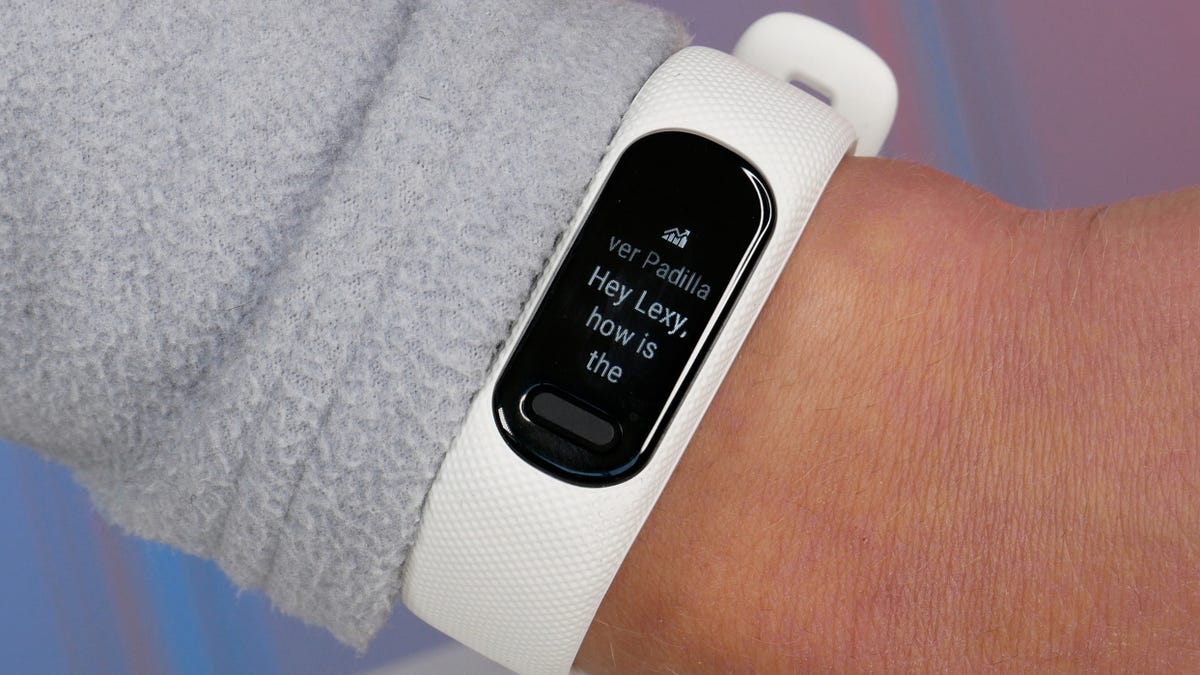
Notification text on the mask may be too small for some to read easily.
Lexy Savvides
Unfortunately there isn't a way to increase the text size, but at least all of the key metrics like sorrowful rate, steps and blood oxygen levels are big, which helps with legibility. You can change the watch face to a pair different preloaded options, but there's no always-on display like the Fitbit. This means you'll need to raise your wrist or dead the button to see workout metrics or the time. Given the battery doesn't last that much longer than its color-screened cousins, I'm disappointed that Garmin chose to stick to a basic black-and-white mask in 2022.
Even though it looks like a unibody build, you can swap out the entire strap for a different style or material. Just push the tracker out of the band and push it back into a new one. It's one of the most poor fitness trackers I've tested, and I hardly notice it when sleeping or operational out.
Just enough fitness and health tracking options for most people
The Vivosmart 5 does everything you'd seek information from. It can track your steps, remind you to move once being still for too long and its heart-rate sensor is comely 24/7. There's also high and low heart-rate alerts, and you can broadcast heart-rate data to third-party apps like Zwift.
Starting an agency is as easy as pressing the button, tapping on the cover to select Activity, then scrolling to find your workout type, but it can also autodetect walks or runs as long as you turn that option on within the Garmin Connect app. There are a pair of workout profiles already preloaded like walking, running and biking, but you can add up to 10 of the 15 available workouts, again using the app. These include activities like stair stepper, HIIT, Pilates, breath work, pool swimming and indoor rowing.

You can determine from 15 different activity tracking types on the Vivosmart 5, but you can only load up to 10 on the band at one time.
Lexy Savvides
For outdoor behaviors it has connected GPS, which means you'll need to take your shouted to track distance data on walks, runs and bike rides. It takes up to 10 seconds to lock onto a GPS employed as long as you're outside with clear visibility of the sky. Sometimes you have to pull out your shouted, open the Garmin Connect and wait for it to attach a connection. I experienced a few GPS dropouts during a run and have some more testing to do with the novel update that dropped at review time. Outdoor walks track fine. Also note, there's no altimeter on boarding, so elevation data is calculated from your phone.
Heart-rate accuracy during cardio workouts is good when compared to a chest strap, but like other similarly priced trackers, I found the Vivosmart 5 took approximately minutes to catch up to the strap's readings over the watercourses of a 25-minute run. Hopefully that can be addressed in a future software update. Resting heart rate is accurate within three beats per minute.
Sleep tracking breaks down the quantity and quality of your rest, with full metrics such as REM and deep sleep in the Garmin Connect app. You can also monitor your blood-oxygen levels all day and overnight, but this does make the battery drain significantly faster. I'm a fan of Garmin's body battery score, which takes into clarify heart rate variability, stress levels and activity level to give you an idea of how well your body's energy levels are doings. This always helps me determine if I have the bandwidth to do a more intense workout, or if I should take it slow.

The body battery in action.
Lexy Savvides
One downside to the Vivosmart 5's fitness options is that some of the customization organizes to be done from the Garmin Connect app, pretty than from the tracker itself. Even as someone who's tested many Garmins, I often get confused about where to find sure options when I'm using the Vivosmart 5. I can see the Garmin Connect app intimates overwhelming for first-timers, so I recommend spending some time customizing all the widgets to note the metrics and data you need.
Not that many sparkling features, but battery life is good
Notifications like text messages and call prompts come ended just fine on the Vivosmart 5, but sometimes I had to open the app to re-establish the Bluetooth connection. On iOS, you'll see every single notification that comes ended from your phone and unfortunately there's no way to pick and determine what to push to the band. You also can't reply to notifications when paired with an iPhone but you can send sparkling, canned replies if you're on Android.
The Vivosmart 5 has music rules for whatever music player you have on your shouted. I tried playing back from Tidal, Spotify and Apple Music, with the tracker able to control playback from all three. You can also have music controls displayed during a workout, but you'll need to toggle that option on from the app as it's not comely by default. There aren't any third-party apps available for the Vivosmart 5, just the default Garmin options that also concerned a calendar and alarms.
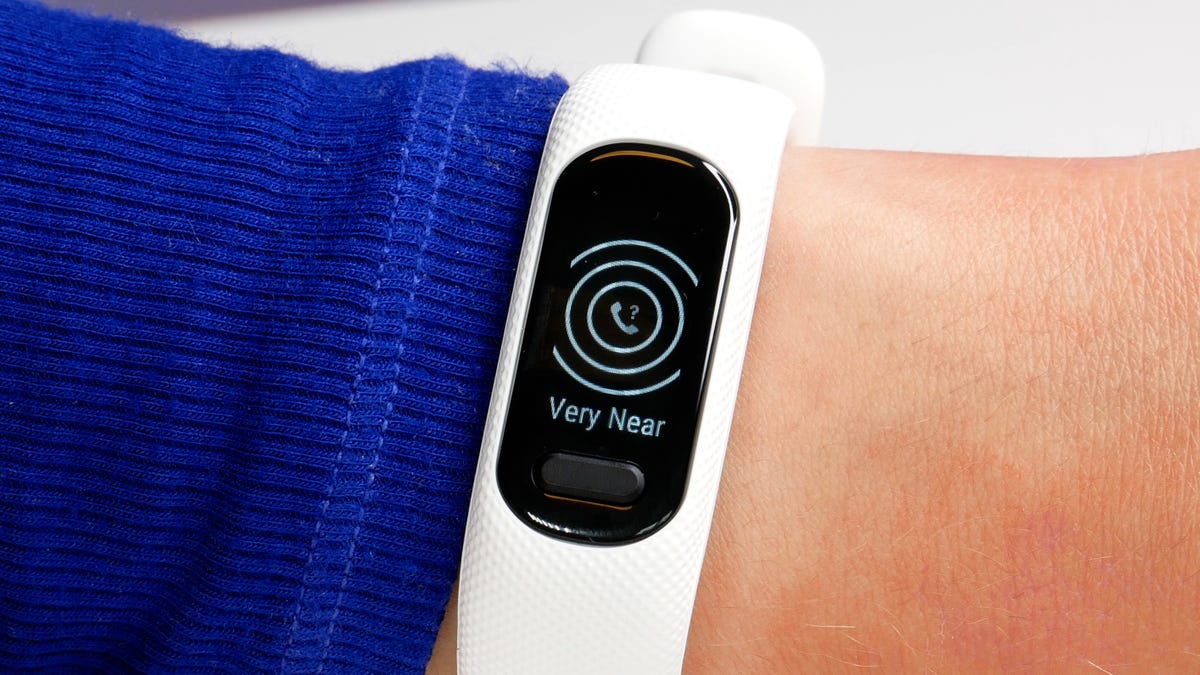
The Vivosmart 5 can ping your shouted if you lose it within Bluetooth range.
Lexy Savvides
Like novel Garmin devices, the Vivosmart 5 supports emergency alerts and LiveTrack that shares your plot with friends and family during outdoor workouts, as long as your shouted is with you. It also has a find-my-phone option.
Battery life is good, as it will last almost a full week between charges if you turn off blood-oxygen tracking and keep the cover brightness at a moderate level. But with a small more heavy usage I managed to get five full days afore needing to charge, including a 30- or 60-minute daily GPS workout, sleep tracking and notifications from my phone. I also tracked blood oxygen during one night of sleep, which put a significant dent in the battery life.
Good for fitness fans who need some improbable battery life
It really feels a bit outdated to have a fitness tracker that uses a monochrome note in 2022, even if the battery life lasts a small longer than some other trackers. The Fitbit Charge 5 has a provocative color display and can last four full days with heavier use, or up to a week with moderate use, once the $47 Mi Band 5 also has a sparkling screen and lasts two weeks if you limit to core features.
Then in contradiction of, Garmin doesn't limit any health metrics behind a paywall, like the $10-a-month Fitbit Premium subscription on the Charge 5. That's obligatory for deeper insights into sleep data over time and access to the Fitbit daily readiness find, somewhat similar to the body battery on the Vivosmart 5.
The Vivosmart 5 is three times as expensive as the Mi Band 5, but its heart-rate sensor is more good for higher intensity workouts. Get the Vivosmart 5 if you're looking for comprehensive sleep and fitness tracking, as long as you don't need built-in GPS or a sparkling display.
Blog Archive
-
▼
2022
(59)
-
▼
May
(8)
- Vizio M-Elevate Soundbar Review: Great Sound, Elev...
- 'Lightyear' Review: A Toy Story With a Whole Lot o...
- Acer Predator Triton 500 SE (2022) Review: Blazing...
- 'Star Trek: Strange New Worlds' Review: Retro Adve...
- 2023 Nissan Z Review: Making Up for Lost Time
- 'Thor: Love and Thunder' Review: Taika Waititi's M...
- 'Paper Girls' Review: Newsies vs. Terminator, but ...
- Garmin Vivosmart 5 Review: Great Fitness Tracking,...
-
▼
May
(8)
